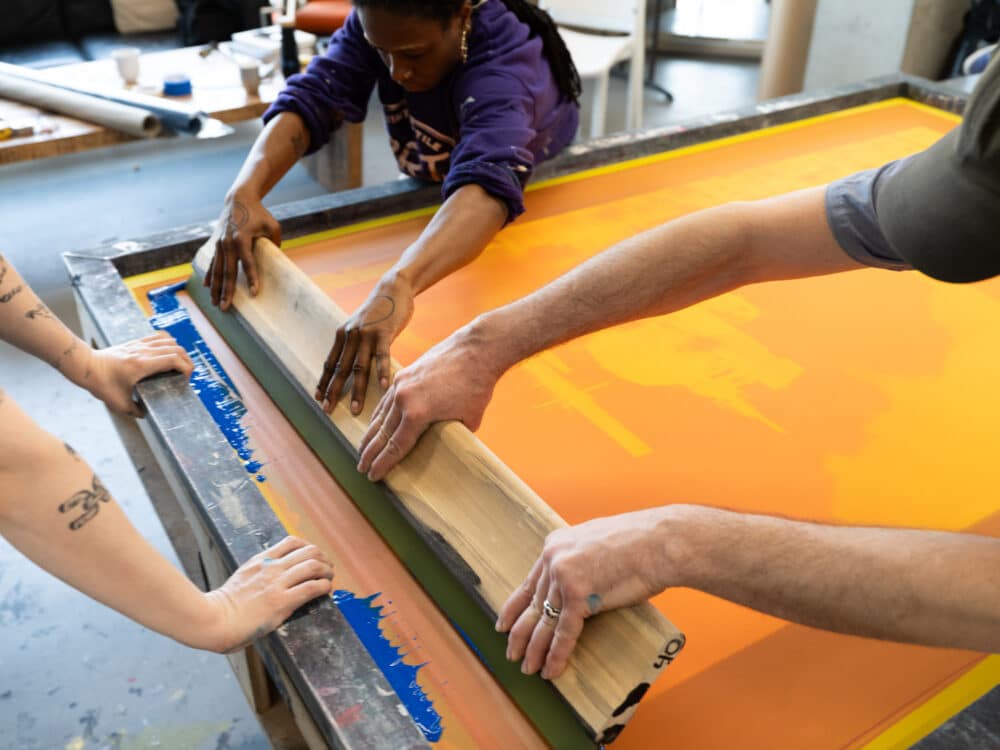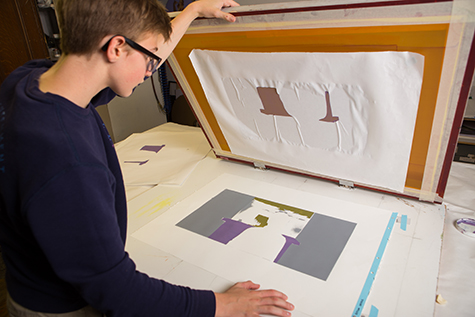Discover the Various Kinds Of Screen Printing Techniques for Your Following Task
Screen printing uses a diverse variety of strategies that can improve any kind of imaginative job. From standard techniques like serigraphy to modern-day innovations such as direct-to-garment printing, each approach has its one-of-a-kind advantages. Specialty options, including eco-friendly and metallic inks, present also much more opportunities. Understanding these techniques can substantially affect the final end result. Nonetheless, the obstacle depends on selecting the most suitable method for details needs and desired results. What aspects should one consider?

The Essentials of Screen Printing
Screen printing may appear facility, it is fundamentally a simple procedure that involves transferring ink through a mesh screen onto various surfaces. The strategy starts with the creation of a pattern, which specifies the design to be published. This stencil is affixed to a mesh screen, normally made of polyester or nylon. Once the stencil is in location, ink is used to the screen and pressed with the mesh using a squeegee, causing the preferred pattern being printed on the underlying material.
Screen printing can be performed on a vast array of substratums, consisting of material, plastic, and paper, making it a versatile selection for numerous projects. The process enables intricate designs and vibrant shades, making it preferred in markets such as art, fashion, and advertising and marketing. Comprehending these basics outfits individuals with the foundational understanding needed to discover advanced methods in screen printing.
Traditional Screen Printing Techniques
Typical screen printing techniques have been utilized for centuries, preserving the workmanship and virtuosity of this method. This strategy uses a mesh screen to move ink onto a substratum, such as textile or paper, enabling vivid and durable layouts. The procedure starts with creating a pattern, which blocks particular areas of the screen to manage where the ink will certainly be used.
One prominent technique is serigraphy, typically used for artistic prints and minimal versions. One more is the usage of water-based inks, which are green and provide a soft feel on fabrics - 10:9 Design Company. Additionally, standard approaches can consist of hands-on printing, where artisans use ink with a squeegee, making certain precision and focus to detail
These techniques stay valued in the market for their responsive quality and the distinct appearances they create, attracting both designers and customers that value the heritage of screen printing.
Digital Screen Printing Innovations
As the need for faster manufacturing and personalization in the printing industry has surged, electronic screen printing technologies have actually emerged as a game-changer. This modern technology mixes typical screen printing techniques with electronic procedures, permitting for rapid prototyping and detailed layouts that were previously difficult to accomplish. One substantial improvement is the intro of direct-to-garment (DTG) printing, which promotes premium, full-color prints on various textiles without the need for displays. Furthermore, developments in ink solutions have resulted in environmentally friendly choices that maintain dynamic shades while minimizing environmental influence. The usage of automated systems further streamlines production, minimizing labor prices and enhancing accuracy. These innovations not only accommodate little set orders and tailored designs but additionally permit for quicker turn-around times, making them ideal for businesses concentrated on conference consumer demands in a busy market. Digital screen printing, as a result, represents a necessary development in the domain of printing methods.
Specialty Screen Printing Techniques
Discovering specialized screen printing approaches discloses a varied variety of methods that push the boundaries of imagination and capability in the printing sector. Amongst these, glow-in-the-dark inks supply an one-of-a-kind aesthetic effect, making designs come alive in low-light problems. Metal inks, understood for their sparkling coating, add a touch of deluxe to published products. Another cutting-edge method is discharge printing, which eliminates color from the material as opposed to adding ink, leading to a soft, classic feeling. High-density printing develops a raised structure on the surface, boosting tactile engagement. In addition, water-based inks are getting appeal for their vibrant shades and minimized environmental impact. Each of these specialized methods deals with details design requirements, allowing brand names and musicians to develop standout items that reverberate with their target markets. By leveraging these methods, companies can elevate their screen printing tasks to new heights, guaranteeing memorable impacts.
Eco-Friendly Screen Printing Options
Eco-friendly screen printing options are getting grip as the market shifts in the direction of sustainability. Lasting ink choices and the use of eco-friendly products are vital components in decreasing the environmental effect of the printing process. By taking on these practices, screen printers can add to a more lasting future while maintaining high-grade outcomes.
Lasting Ink Choices

Biodegradable Materials Use
As the screen printing industry advances, the consolidation of naturally degradable products is coming to be progressively important for environmentally aware practices. Developers and producers are currently discovering inks and substrates made from natural, sustainable sources that decay much more successfully than typical counterparts. These naturally degradable choices reduce plastic waste and decrease ecological effect, straightening with the growing demand for sustainable items.
Common examples include water-based inks and organic cotton textiles, both of which lessen harmful chemicals and advertise eco-friendliness. Brand names that adopt these materials often improve their market charm, drawing in consumers that focus on sustainability. As recognition of ecological concerns proceeds to increase, the shift in the direction of biodegradable materials in screen printing is most likely to acquire momentum, promoting a website greener market requirement.
Choosing the Right Technique for Your Project
Just how can one identify the most suitable screen printing method for a certain job? The decision depends upon a number of variables, consisting of the product to be published on, the intricacy of the style, and the preferred production volume - 10:9 Design Abilene. Direct-to-garment printing is perfect for intricate styles with countless colors, while standard screen printing excels for bigger runs of less complex graphics.
Furthermore, factor to consider of the end-use of the published item is essential. For outside applications, techniques that supply resilience and weather resistance, such as plastisol ink, might be liked. On the other hand, environmentally-conscious tasks might profit from water-based inks or biodegradable products.
Ultimately, comprehending the project's one-of-a-kind needs allows for an informed option, ensuring both aesthetic allure and functional longevity. By reviewing design intricacy, material compatibility, and manufacturing range, one can effectively choose one of the most appropriate screen printing method to fulfill their task's goals.
Often Asked Concerns
What Is the History of Screen Printing?
Screen printing came from old China around 1000 AD, developing via Japan and Europe. By the 20th century, it became preferred in business art and style, revolutionizing exactly how designs were produced and distributed around the world.

Just how Do I Prepare Artwork for Screen Printing?
To prepare art work for screen printing, one must guarantee high resolution, utilize an appropriate shade setting, produce separate layers for every color, and transform text to outlines, ensuring compatibility with the printing process and wanted result.
What Products Are Best for Screen Printing?
The best materials for screen printing consist of high-grade inks, resilient displays, and suitable substrates like cotton, polyester, or blends. Additionally, utilizing suitable emulsion and squeegees can boost the printing process and results.
Can I Screen Publish at Home?
Yes, screen printing in the house is possible. With the ideal products, setup, and strategies, individuals can create high-grade prints. However, mindful consideration of office and tools is necessary for successful results.

What Are Common Blunders in Screen Printing?
Usual errors in screen printing include inappropriate direct exposure times, insufficient ink uniformity, misalignment of displays, inadequate cleaning of products, and ignoring to evaluate prints. These mistakes can jeopardize the quality and precision of the end product.
Screen printing might seem complex, it is essentially an uncomplicated process that includes transferring ink through a mesh screen onto different surfaces. As the need for faster production and customization in the printing market has risen, electronic screen printing innovations have actually emerged as a game-changer. Checking out specialty screen printing techniques reveals a varied range of methods that press the boundaries of creative thinking and performance in the printing sector. The best materials for screen printing consist of high-grade inks, sturdy screens, and suitable substratums like cotton, polyester, or blends (10:9 Design Screen Printing Texas). Typical mistakes in screen printing consist of improper exposure times, poor ink consistency, misalignment of displays, insufficient cleansing of products, and overlooking to examine prints